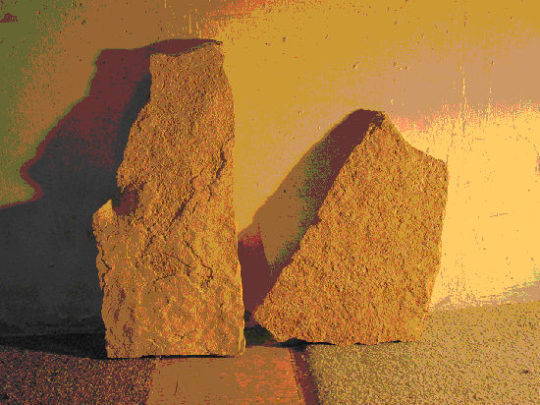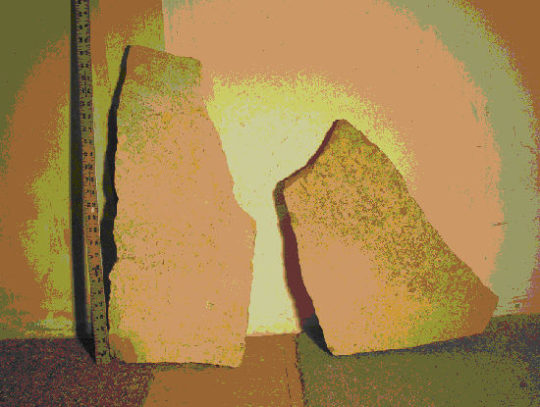Continuing the saga of Jasmine’s Garden…
In my studio, I closely examined the two possible stones for the memorial. The stone sides differed in textures. On the backside of the tallest stone, the texture had furrows and a circular gouge that would create great shadows as the sun passed by. The backside of the shorter stone had a rugged rough texture. Though not having the same ambience as the taller stone, it truly exhibited a beauty all its own.
Back side of the two possible memorial stones

But it was the front sides of the stones that presented the great dilemma. The sides were flat, ‘tis true, but porous all the same.
Each little gray spot is one or more cavities.

Front side of the memorial stones with yardstick to the left.
In the past, when I painted rocks (which were all outside rocks, huge, and unmovable), I would seal the rock first with a matte varnish. But even though I varnished first, I practically had to shovel in the paint and it still did not fill the holes to my satisfaction. When the paint would dry, there would be an indentation as if I had not added extra paint. Despite this, the rock owners were always pleased with the results of my rock painting. Moreover, I have to admit, even though painting under these conditions, the end artwork did look great.
But because this present stone was to mark an extra special place in memory of an extra special little girl, I wanted it to look perfect. I asked fellow artists for advice on how they would fill in the small cavities. One mentioned her son filled in the holes in her steps with a concrete mix. So she suggested that I fill in the cavities with this.
I checked it out at Menard’s, but something in my gut told me this wasn’t the way for various reasons.
- First, if I filled each cavity as needed, talk about time-consuming and plenty of “This is driving me NUTS” moments. There are too many cavities to fill.
- And I didn’t want to create a whole new facade on the stone by covering the whole side of the rock with a layer of mix.
- If I did that, then another problem arises: the concrete color had to synchronize with the stone color.
- Lastly, there was the problem of how would the thin mix react to the elements of weather. It’s spring here in Iowa and pot-holes abound. Well, the same thing could happen to the concrete in the cavities; if water entered a cavity and forced the mix out, the whole facade would be ruined.
Then the creative side of my brain began to play with other ideas to decorate the stone, such as mosaics or etching / carving into the stone, but none satisfied my quest. To be truthful, I did some heavy praying. Not giving up, I visited the Dick Blick Art Store to pick some artsy brains that work there. It was midway in the middle of a discussion about pottery, glazing, and kilns, when the answer came to me! My heart skipped a beat! I knew EXACTLY what would work!
Next week the answer and the pattern, which wasn’t exactly in the direction that Linda had suggested. Would she be open to this new pattern?…Next Monday…